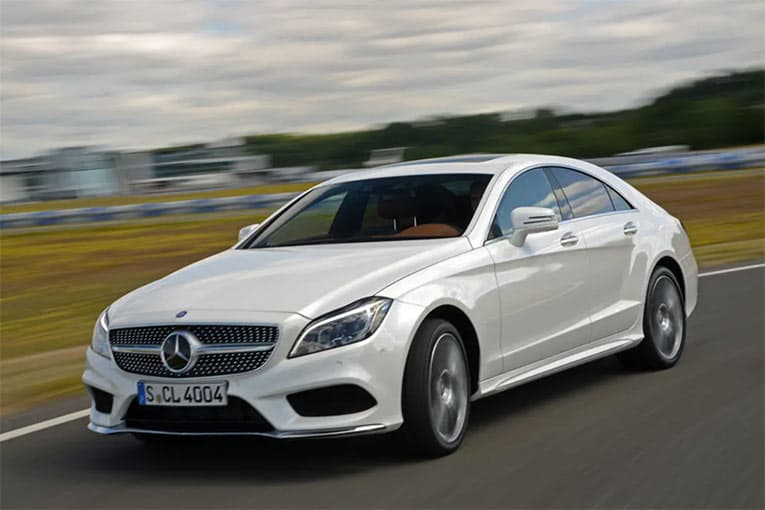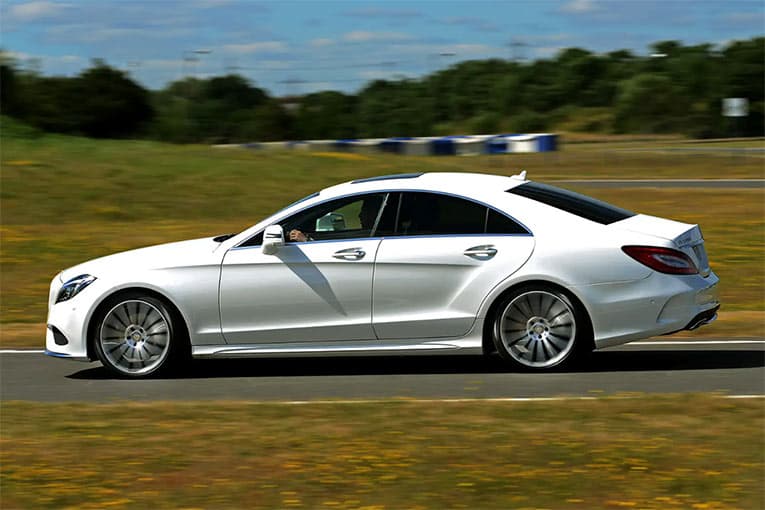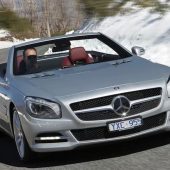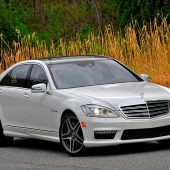It still is easily recognisable. The long bonnet, short rear boot lid, frameless side windows and roofline which slowly drops towards the end of the car. The proportions of the design have stayed unchanged. Yet the second generation CLS have completely new look. The front of the car has clearly borrowed some bits from the new SLS AMG. The front looks now much more aggressive and the large star in the radiator grille won’t be unnoticed. One distinguishing and also technicically interesting feature are the headlamps, where all of the regular dynamic light functions use LED technology. A total of 71 LEDs are in three arrow-shaped layers. The upper layer contains the LED indicator, second layer is the LED side light offering LED low beam functions and the lowest level of the headlamp houses the main beam and nightview functions. The rear lights have familiar triangular shape, but are much more rounded than before. The new CLS surely looks good, but I’m not sure if it can match the previous model, as the first CLS looked fantastic.

To power the new CLS there are four engines available. Two diesels and two petrols, which all have increased performance. For the sporty looking four-door, a petrol engine would the obvious choice. Then you can choose between CLS 350 (306 hp) and CLS 500 (408 hp). Eventhough the CLS 350 is 10 percent more powerful, it’s 25 percent more economical than before. Thanks to third-generation BlueDIRECT injection technology, the V6 petrol engine in the CLS 350 now consumes just 6.8 litres per 100 km and matches this 350 CDI diesel in terms of CO2 emissions at 159 g/100 km. This makes the V6 petrol engine a very tempting choice. The most economical choice is the CLS 250 CDI. This four-cylinder diesel is now available for the first time in the four-door coupe. Four-cylinder diesel might sound quite modest for the CLS, but with the maximum output of 204 horsepower and especially the 500 Newton metres of torque means that the performance is surprisingly good. The acceleration to a hundred takes 7.5 seconds and the top speed is 242 km/h, while the fuel consumption is only 5,1 litres per 100 km and the CO2 emissions 134 g/km.
We drove the CLS 350 CDI with the 3.0-litre V6, which is more powerful than before. 265 horsepower and massive 620 Newton metres of torque means that there is now shortage of power. Therefore the performance figures are impressive for a diesel. CLS 350 CDI can accelerate to a hundred in 6,2 seconds and reach top speed of 250 km/h. Despite the extra 30 kW and 80 Nm, the V6 has improved its fuel efficiency. The average fuel consumption is only 6,0 litres per 100 km. Although reaching this number means that you have to be quite careful with the throttle. To achieve these improvements with the performance and economy, the Mercedes engineers have basically revised the engine. It now has improved engine management with the new-generation control units and new software, new sensors and actuators, and more efficient aftertreatment in the diesel particulate filter system with reduced back-pressure. The in-engine measures include a reduction of the compression ratio from 17.7:1 to 15.5:1, an optimised VNT turbocharger with low-friction shaft bearings, new injection nozzles and revised intake ducting.

All CLS models come with the seven-speen automatic transmission as standard. The torque converter and main transmission have been developed and improved for better fuel consumption and comfort. The new generation of the torque converter provides an improved response, better durability and reduced noise and vibration levels. In addition, the gearshift program in ECO mode has been changed in favour of lower engine rpm at cruising speeds. Another new feature is the electromechanical power steering system. As the steering support system only uses energy when the vehicle is actually being steered, fuel consumption is cut by up to 0.3 litres and 7 g of CO2 compared to the previous model. The first CLS was something new and completely different than anything else what was available at the time. The four door coupe looked amazing and was sportier choice for the E-Class sedan. This second generation continues with the same concept. Eventhough it has more power and is even better to drive than before, it feels like there’s something missing. There’s nothing wrong with the car itself, but when it is a new CLS, you start to expect something even more special. Maybe I just have to admit the fact that you can’t create that first impression again and realise that it is after all just a car. A great one. But a car.
Specification
Engine
- Diesel
- 6-cylinder
- 2987cc
- Turbo
Power
- 195 kW (265 hp) / 3800rpm

Torque
- 620 Nm / 1600-2400rpm
Transmission
- 7-speed automatic
- RWD
0-100km/h / 0-62mph
- 6.2 seconds
Top speed
- 250 km/h
Fuel consumption
- 6.0 l/100km
CO2 emissions
- 159 g/km










